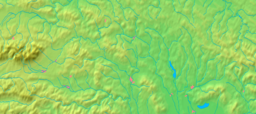Stará Ľubovňa
| Stará Ľubovňa | |
| City | |
|
Stará Ľubovňa Castle and an open-air folk museum
|
|
| Nickname: Lubovna | |
| Country | Slovakia |
|---|---|
| Region | Prešov |
| District | Stará Ľubovňa |
| Tourism region | Spiš |
| River | Poprad |
| Elevation | 545 m (1,788 ft) |
| Coordinates | 49°18′34″N 20°40′44″E / 49.30944°N 20.67889°ECoordinates: 49°18′34″N 20°40′44″E / 49.30944°N 20.67889°E |
| Area | 30.79 km2 (11.89 sq mi) |
| Population | 16,363 (31 December 2005) |
| Density | 531/km2 (1,375/sq mi) |
| First mentioned | 1292 |
| Mayor | Ľuboš Tomko |
| Timezone | CET (UTC+1) |
| - summer (DST) | CEST (UTC+2) |
| Postal code | 064 01 |
| Area code | +421-52 |
| Car plate | SL |
| Statistics: MOŠ/MIS | |
| Website: www.staralubovna.sk | |
Stará Ľubovňa (German: Altlublau; Hungarian: Ólubló; Latin: Lublovia; Polish: Lubowla) is a town with approximately 16,000 inhabitants in northeastern Slovakia. The town consists of the districts Podsadek and Stará Ľubovňa.
The name is of Slovak or Slavic origin and is potentially derived from a personal name. It comes from a root ľub- meaning lovely, nicely. The same root is present in Czech Libeň, Polish Lublin, Slovenian Ljubljana and others similar Slavic geographic names. The German name Altlublau and the Hungarian Ólubló were derived from the Slovak version.
Stará Ľubovňa is situated on the Poprad River 15 kilometres (9 miles) south of the Polish border and 30 kilometres (19 miles) east of the High Tatras. It is one of the oldest towns in the Spiš, an historic administrative county (comitatus) of the Kingdom of Hungary, and is today the administrative capital of the district of Stará Ľubovňa in the Prešov Region.
In 1292 Stará Ľubovňa is first mentioned as Libenow. Until it became a free royal town in 1364 the town fell under the jurisdiction of the castle.
In 1412 it belonged to the 16 Spiš towns given by the Hungarian King Sigismund of Luxemburg as a deposit to King Władysław II of Poland. The pledge was part of the Treaty of Lubowla and was thought to be only for a short time, but it finally lasted for 360 years. Only in the course of the first Partition of Poland in 1772 during the reign of Maria Theresa of Austria the territory came back to the Kingdom of Hungary. The pledge was actually an advantage for the towns concerned because they did not have to submit themselves to the comitatus or nobility and had a neutral position in turmoils between Poland and Hungary.
...
Wikipedia





